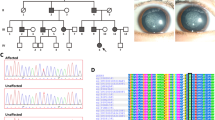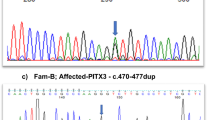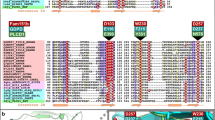Abstract
The major intrinsic protein (MIP) of the vertebrate eye lens is the first identified member of a sequence-related family of cell-membrane proteins that appears to have evolved by gene duplication1. Several members of the MIP family transport water (aquaporins), glycerol and other small molecules in microbial, plant and animal cells2. Mutations in two aquaporin homologues of MIP underlie an autosomal recessive form of nephrogenic diabetes insipidus3 and absence of the Colton blood group antigens4 in humans, whereas, mutation of a third MIP-like gene underlies ‘big brain’ development in Drosophila5. Here we show that distinct mutations in the murine Mip gene underlie one form of autosomal dominant cataract in the mouse. The cataract Fraser mutation is a transposon-induced splicing error that substitutes a long terminal repeat sequence for the carboxy-terminus of MIP. The lens opacity mutation is an amino-acid substitution that inhibits targeting of MIP to the cell-membrane. These allelic cataract mutations provide the first direct evidence that MIP plays a crucial role in the development of a transparent eye lens.
This is a preview of subscription content, access via your institution
Access options
Subscribe to this journal
Receive 12 print issues and online access
$209.00 per year
only $17.42 per issue
Buy this article
- Purchase on Springer Link
- Instant access to full article PDF
Prices may be subject to local taxes which are calculated during checkout
Similar content being viewed by others
References
Reizer, J., Reizer, A. & Saier, M.H. The MIP family of integral membrane channel proteins: sequence comparisons, evolutionary relationships, reconstructed pathway of evolution and proposed functional differentiation of the two repeated halves of the proteins. Crit Rev. Biochem. Molec. Biol. 28, 235–257 (1993).
Chrispeels, M.J. & Agre, P. Aquaporins: water channel proteins of plant and animal cells. Trends. Biochem. Sci. 19, 421–425 (1994).
van Lieburg, A.F., et al. Patients with autosomal nephrogenic diabetes insipidus homozygous for mutations in the aquaporin 2 water-channel gene. Am. J. Hum. Genet. 55, 648–652 (1994).
Preston, G.M., Smith, B.L., Zeidel, M.L., Moulds, J.J. & Agre, P. Mutations in aquaporin-1 in phenotypically normal humans without functional CHIP water channels. Science 265, 1585–1587 (1994).
Rao, Y., Van, L.Y. & Jan, Y.N. Similarity of the product of the Drosophila neurogenic gene big brain to transmembrane channel proteins. Nature 345, 163–167 (1990).
Fraser, F.C. & Schabtach, G. ‘Shirvelled’: a hereditary degeneration of the lens in the house mouse. Genet. Res. 3, 383–387 (1962).
Muggleton-Harris, A.L., Festing, M.F.W. & Hall, M. A gene location for the inheritance of the Cataract Fraser (Catfr) mouse congenital cataract.Genet. Res. 49, 235–238 (1987).
Lyon, M.F., Jarvis, S.E., Sayers, I. & Holmes, R.S. Lens opacity: a new gene for congenital cataract on chromosome 10 of the mouse. Genet. Res. 38, 337–341 (1981).
Muggleton-Harris, A.L. & Higbee, N. An in vivo and in vitro study of the embryonic and adult Lop mutant congenital cataractous lens. Exp. Eye Res. 44, 805–815 (1987).
Yancey, S.B., Koh, K., Chung, J. & J-R Expression of the gene for main intrinsic polypeptide (MIP): separate spatial distributions of MIP and γ-crystallin gene transcripts in rat lens development. J. Cell Biol. 106, 705–714 (1988).
Griffin, C.S. & Shiels, A. Localisation of the gene for the major intrinsic protein of eye-lens fibre cell membranes to mouse chromosome 10 by in situ hybridisation. Cytogenet Cell Genet. 59, 300–302 (1992).
Breen, M. et al. Towards high resolution maps of the mouse and human genomes - a facility for ordering markers to 0.1 cM resolution. Hum. Mol. Genet. 3, 621–627 (1994).
Shiels, A. & Griffin, C.S. Aberrant expression of the gene for lens major intrinsic protein in the CAT mouse. Curr. Eye Res. 12, 913–921 (1993).
Pisano, M.M. & Chepelinsky, A.B. Genomic cloning, complete nucleotide sequence and structure of the human gene encoding the major intrinsic protein (MIP) of the lens. Genomics 11, 981–990 (1991).
Kaghad, M., Maillet, L. & Brulet, P. Retroviral characteristics of the long terminal repeat of murine E.Tn sequences. EMBOJ. 4, 2911–2915 (1985).
Shiels, A., Griffin, C.S. & Muggleton-Harris, A.L. Restriction fragment length polymorphisms associated with the gene for the major intrinsic protein of eye-lens fibre cell membranes in mice with hereditary cataracts. Btochim. Biophys. Acta. 1097, 81–85 (1991).
Shiels, A., Griffin, C.S. & Muggleton-Harris, A.L. Immunochemical comparison of the major intrinsic protein of eye-lens fibre cell membranes in mice with hereditary cataracts. Biochim. Biophys. Acta. 1097, 318–324 (1991).
Vaux, D., Tooze, J. & Fuller, S. Identification by anti-idiotype antibodies of an intracellular membrane protein that recognises a mammalian endoplasmic reticulum retention signal. Nature 345, 495–502 (1990).
Mulders, S.M. et al. Water channel properties of major intrinsic protein (MIP) of lens. J. Biol. Chem. 270, 9010–9016 (1995).
Kushmerick, C., Rice, S.J., Baldo, G.J., Haspel, H.C. & Mathias, R.T., Ion, water and neutral solute transport in Xenopus oocytes expressing frog lens MIP. Exp. Eye Res. 61, 351–362 (1995).
Zampighi, G.A., Simon, S.A. & Hall, J.E. The specialised junctions of the lens. Int. Rev. Cytol. 136, 185–225 (1992).
Michea, L.F., Andrinolo, D., Ceppi, H. & Lagos, N. Biochemical evidence for adhesion-promoting role of major intrinsic protein isolated from both normal and cataractous human lenses. Exp. Eye Res. 61, 293–301.
Brakenhoff, R.H., Henskens, H.A.M. ., van Rossum, M.W.P.C., Lubsen, N.H., & Schoenmakers, J. G. G., Activation of the γE-crystallin pseudogene in the human hereditary Coppock-like cataract. Hum. Mol. Genet. 3, 279–283 (1994).
Chambers, C. & Russell, P. Deletion mutation in an eye lens β-crystallin. J. Biol. Chem. 266, 6742–6746 (1991).
Cartier, M., Breitman, M.L. & Tsui, L.-C. A frameshift mutation in the γE-crystallin gene of the Elo mouse.Nature Genet. 2, 42–45 (1992).
Rodriguez, I.R., Gonzalez, P., Zigler, J.S. & Borras, T. A guinea-pig hereditary cataract contains a splice-site deletion in a crystallin gene. Biochim. Biophys. Acta. 1180, 44–52 (1992).
Muggleton-Harris, A.L., Hardy, K. & Higbee, N. Rescue of lens developmental abnormalities in chimeras of non-cataractous and congenital cataractous mice. Development. 99, 473–480 (1987).
Kent, N.A. & Shiels, A. Nucleotide and derived amino acid sequence of the major intrinsic protein of rat eye lens. Nucl. Acids Res. 18, 4256 (1990).
Bassnett, S. The fate of the golgi apparatus and the endoplasmic reticulum during lens fiber cell differentiation. Invest. Ophthalmol. Vis. Sci. 36, 1793–1803 (1995).
Griffin, C.S. & Shiels, A. In situ hybridisation localises the gene for the major intrinsic protein of eye lens fibre cell membranes to human chromosome 12q14. Cytogenet. Cell Genet. 61, 8–9 (1992).
Saito, F. et al. Human AQP2 and MIP genes, two members of the MIP family, map within chromosome band 12q13 on the basis of two color FISH. Cytogenet. Cell Genet. 68, 45–48 (1995).
Author information
Authors and Affiliations
Rights and permissions
About this article
Cite this article
Shiels, A., Bassnett, S. Mutations in the founder of the MIP gene family underlie cataract development in the mouse. Nat Genet 12, 212–215 (1996). https://doi.org/10.1038/ng0296-212
Received:
Accepted:
Issue Date:
DOI: https://doi.org/10.1038/ng0296-212
This article is cited by
-
RNA-Seq analysis in giant pandas reveals the differential expression of multiple genes involved in cataract formation
BMC Genomic Data (2021)
-
A novel missense mutation in the gene encoding major intrinsic protein (MIP) in a Giant panda with unilateral cataract formation
BMC Genomics (2021)
-
The relationship between major intrinsic protein genes and cataract
International Ophthalmology (2021)
-
Mouse models for microphthalmia, anophthalmia and cataracts
Human Genetics (2019)
-
Quantitative Analysis of Aquaporin Expression Levels during the Development and Maturation of the Inner Ear
Journal of the Association for Research in Otolaryngology (2017)



